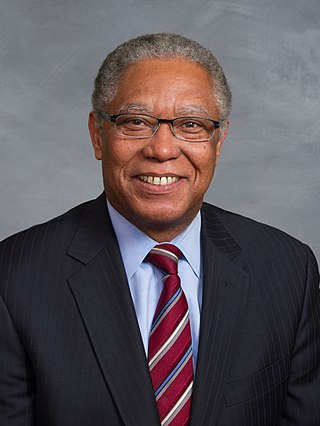Senatorial courtesy is a long-standing, unwritten, unofficial, and nonbinding constitutional convention in the U.S. describing the tendency of U.S. senators to support a Senate colleague opposing the appointment to federal office of a nominee from that senator's state. The practice is motivated by a general sense of collegiality among senators and the assumption that a Senate colleague will have the best first-hand knowledge of the personal character and qualifications of a nominee from the senator's own state. It is also viewed as an "important source of political patronage" for U.S. senators.

Richard Allen Griffin is a United States circuit judge of the United States Court of Appeals for the Sixth Circuit. Previously, he was a judge on the Michigan Court of Appeals.

Daniel Terry Blue Jr. is an American politician and attorney serving as a member of the North Carolina Senate, representing the state's 14th Senate district, and is the Senate minority leader.
The Origination Clause, sometimes called the Revenue Clause, is Article I, Section 7, Clause 1 of the U.S. Constitution. The clause says that all bills for raising revenue must start in the U.S. House of Representatives, but the U.S. Senate may propose or concur with amendments, as in the case of other bills.

The United States Senate is the upper chamber of the United States Congress. Together, the United States Senate and the United States House of Representatives comprise the federal bicameral legislature of the United States. The Senate plays a role in the passage of federal legislation; it also confirms presidential appointments and provides a vital check and balance on the powers of the executive and judicial branches of government.
U.S. President Barack Obama nominated over 400 individuals for federal judgeships during his presidency. Of these nominations, Congress confirmed 329 judgeships, 173 during the 111th & 112th Congresses and 156 during the 113th and 114th Congresses.

The 1996 United States Senate election in Arkansas was held on November 5, 1996. Incumbent Democratic U.S. Senator David Pryor decided to retire. Republican Tim Hutchinson won the open seat, becoming the first Republican to win a U.S. Senate seat in Arkansas since Reconstruction in 1872 and the first to ever be popularly elected in the state. He was the first to win this seat since 1870.

Patty Shwartz is a United States circuit judge of the United States Court of Appeals for the Third Circuit.

Rachelle "Shelly" Lynne Deckert Dick is the Chief United States district judge of the United States District Court for the Middle District of Louisiana. She is the first female judge to serve in the Middle District.

The 2016 United States Senate election in Wisconsin was held November 8, 2016, to elect a member of the United States Senate to represent the State of Wisconsin, concurrently with the 2016 U.S. presidential election, as well as other elections to the United States Senate in other states and elections to the United States House of Representatives and various state and local elections. The primaries were held August 9, 2016.

The 2018 United States Senate election in Delaware took place on November 6, 2018, to elect a member of the United States Senate to represent the State of Delaware, concurrently with other elections to the United States Senate, elections to the United States House of Representatives, and various state and local elections.

The 2018 United States House of Representatives elections in Missouri were held on November 6, 2018, to elect the eight U.S. representatives from the state of Missouri, one from each of the state's eight congressional districts.

Michael Brian Brennan is a United States circuit judge of the United States Court of Appeals for the Seventh Circuit. He was first nominated on August 3, 2017, by President Donald Trump, and was re-nominated in 2018. He was confirmed May 10, 2018. He was previously a partner in the Milwaukee law firm Gass Weber Mullins LLC, and served 8 years as a Wisconsin Circuit Court judge.
Donald Trump, President of the United States from 2017 to 2021, entered office with a significant number of judicial vacancies, including a Supreme Court vacancy due to the death of Antonin Scalia in February 2016. During the first eight months of his presidency, he nominated approximately 50 judges, a significantly higher number than any other recent president had made by that point in his presidency. By June 24, 2020, 200 of his Article III nominees had been confirmed by the United States Senate. According to multiple media outlets, Trump significantly impacted the composition of the Supreme Court and lower courts during his tenure.

Chad Andrew Readler is an American lawyer who serves as a United States circuit judge of the United States Court of Appeals for the Sixth Circuit. He previously served as a principal deputy and former acting assistant attorney general for the United States Department of Justice Civil Division.

Eric Earl Murphy is a United States circuit judge of the United States Court of Appeals for the Sixth Circuit and former Solicitor General of Ohio.

Andre Bernard Mathis is an American lawyer who is serving as a United States circuit judge of the United States Court of Appeals for the Sixth Circuit.

Doris Lenea Pryor is an American lawyer who has served as a United States circuit judge of the United States Court of Appeals for the Seventh Circuit since 2022. She served as a United States magistrate judge for the Southern District of Indiana from 2018 to 2022.

In the Senate, a blue slip is a slip on which the senators from the state of residence of a federal judicial nominee give an opinion on the nominee.
In the House of Representatives, a blue slip is a rejection slip given to tax and spending bills sent to it by the Senate that did not originate in the House, according to the House's interpretation of the Origination Clause of the Constitution of the United States.














